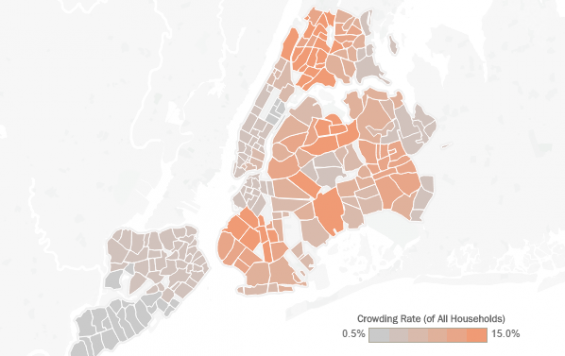
Source: Street Easy
Feb. 26, 2016 By Michael Florio
Queens is home to the four most crowded neighborhoods in New York City, according to a report from the real estate website Street Easy.
The U.S. Census Bureau defines a crowded household as one with more than one person per room.
No neighborhood has a larger portion of crowded homes than Corona, at 23 percent, according to 2013 census data pulled by Street Easy. Right behind it is North Corona with 20.8 percent of homes being overcrowded, followed by East Elmhurst (20.7 percent) and Jackson Heights (20.6 percent).
Although this study used information from the 2013 census, Councilman Daniel Dromm said overcrowding is a longstanding issue that plagues the community.
“Overcrowding in Jackson Heights has been an issue as far back as I can remember,” he said.
He said certain areas of the neighborhood are more crowded than others. Overcrowding often occurs in single and two-family homes, particularly between 71st and 74th Streets, ranging from Roosevelt Avenue to Northern Boulevard.
State Sen. Jose Peralta said he still receives complaints about overcrowding, sometimes with up to 10 people living in a one-family house. He said the issue is evident when walking around parts of East Elmhurst and Corona.
“You often see six or seven satellite dishes on a one-family house,” he said. “There is no way that’s for one family.”
Councilwoman Julissa Ferreras-Copeland believes that these neighborhoods are overcrowded due in part to the many amenities they offer.
“Easy access to transportation, proximity to Flushing Meadows Corona Park and the high-performing schools have made this area a desirable place to live and raise a family,” she said.
Officials also believe this has to do with the neighborhood being a destination for a large immigrant community.
“Immigrant groups tend to live where there are other members from their community and country,” Dromm said. “They can assist them to integrate into American society.”
He noted that neighborhoods in his district have sections with a large population of immigrants from the same country.
About 50 percent of Corona and East Elmhurst’s population and about 60 percent of Jackson Heights’ are immigrants, according to Peralta.
“Given that my district is ground zero for immigrants and newly arrived immigrants, this comes as no surprise,” Peralta added.
The officials also believe an increase on rent citywide, which has driven up the prices in these neighborhoods, is a large factor.
“People are forced to live in cramped apartments because they just can’t afford the rent,” Peralta said.
As people are priced out of other neighborhoods they move into neighborhoods in his district, which leads to more demand, therefore higher rent. This leads to more and more landlords jacking up the price, which forces individuals to consolidate into one home, Peralta said.
To combat this cycle, these officials said they believe that the city needs to invest in more affordable housing.
“This really shouts out the need for affordable housing,” Peralta said. “Hard working immigrants are struggling to make ends meet.”
Ferreras-Copeland stated that she is working on bringing additional affordable housing units to these communities.
“Building more housing that is affordable and giving priority to long-time residents is important,” she said.
Affordable housing needs to be increased citywide, not just on a neighborhood-by-neighborhood basis, Dromm said.
He also said that the neighborhood needs an increase in city services, such as more schools to avoid overcrowding. He has recommended the location of the former White Castle regional headquarters (69-01 34th Ave.). Community Board 3 approved this plan in May.
“Jackson Heights has the most overcrowded school districts in the city,” he said.
Ferreras-Copeland also sees a need for more schools in her district.
“I will also be following the $860 million the mayor allocated for new school construction to see that they are directed to the neighborhoods like mine that need relief from overcrowding the most,” she said.
Additionally, Dromm said an increase in garbage pickup is needed to help deal with the overcrowding problem.
“People oftentimes throw house trash into city garbage cans because they don’t want city agencies to see and realize how many people live in these houses,” he said.
In addition to an increase in affordable housing and services, Peralta believes the minimum wage should be increased, to help combat this overcrowding problem.
“The more money a person makes, the more opportunity they have to be able to afford rent independently,” he said.
He would like to see minimum wage increased to $15 an hour.
One Comment






Department of Buildings doing more inspections of illegal housing would be very helpful.